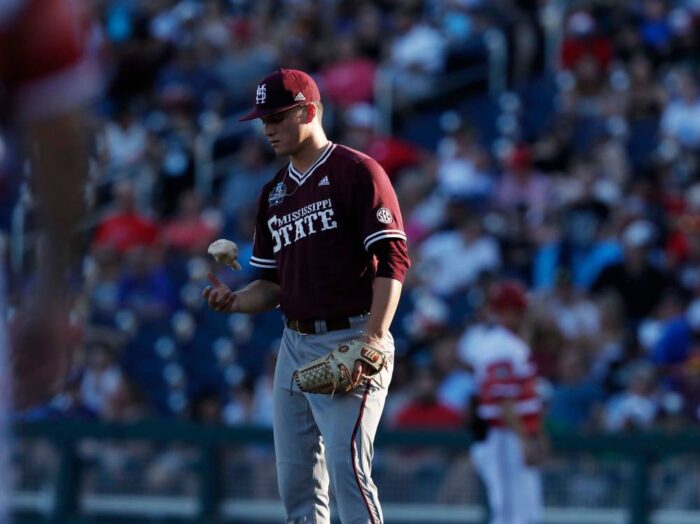
By now, most Mets fans have gotten wind that GM Brodie Van Wagenen and his amateur scouting department are attempting to employ the same strategy that they garnered much praise for after last year’s MLB Amateur Draft. Whereas last June the crown jewel target was Matthew Allan, this year’s unique draft parameters were again manipulated to consolidate the pool allotment into tempting Mississippi State sophomore J.T. Ginn to turn pro.
It’s become pretty obvious that in order to sign Ginn, the Mets are going to have to go way overslot for the 52nd overall draft selection. The Mets indeed appeared to have sacrificed significant pool money and talent in the last three rounds of the draft, in order to meet Ginn’s number. For a pitcher who is currently in the active recovery phase from his Tommy John surgery earlier this spring, it’s a high stakes gamble.
But the two-headed monster atop the Mets amateur scouting department, VP of Amateur and International Scouting Tommy Tanous and Director of Amateur Scouting Marc Tramuta, have had some serious praise and excitement for Ginn’s offerings. Tanous was impressed by Ginn’s ability to generate both ground balls and swings and misses with a “turbo sinker”. You can see what he means:
Nasty sinker from Mets second rounder JT Ginn courtesy of @PitchingNinja.
— Michael Mayer (@mikemayerMMO) June 12, 2020
Van Wagenen has already been speaking publicly about how excited his team was to land multiple “impact” talents with all three of their first picks, including J.T. Ginn. Make no mistake, they see “the qualities of a top-of-the-rotation starter”.
But does the industry agree?
It might depend on who you ask. Fangraph’s Eric Longenhagen writes that while there is some bullpen risk, there is clear #4 starter upside.
Hold up. Clearly, prospect evaluators will differ on specific players, and likely the Mets are “high” on Ginn, while Longenhagen might be “low”. But that is not the ceiling that many fans would expect to hear from a knowledgeable expert source such as Longenhagen.
I mean, Ginn throws hard (sitting about 93-96 mph with his fastball), everyone agrees that he has a nasty plus slider, and the Dodgers were willing to give him over 2 million dollars to sign out of high school in 2018 as the 30th overall pick in that draft class. What do you mean his upside is a #4 starter?
What’s going on here is two-fold. A #4 starter still qualifies as an impact rotation piece, even if he’s not an “ace” or front-line pitcher. That might still very well be worth punting the last three picks of this draft for. Far less pitchers actually have front-line upside than many realize. A #4 starter is also to be distinguished from a back-end depth arm, of which there are many more fish in the sea.
But why wouldn’t an expert like Longenhagen feel comfortable giving a profile like Ginn’s, front-line upside? Obviously there is injury and even bullpen risk with all pitchers, especially one with Ginn’s elbow history. But we’re talking upside here. What gives?
The second part of this lies in the modern pitching philosophy that the new data-age has brought. Teams are more and more looking for the Gerrit Cole archetype: a back-spinning four-seam fastball that has carry through the upper half of the hitting zone, and a matching curveball with 12-6 action to mirror the vertical break. It’s no longer just the Astros. Every MLB club, including the Mets, is listening to the data, and the data says that this repertoire is the best at missing bats. And missing bats is the singular most important thing a pitcher can do, especially if he’s going to be considered a front-line starter.
J.T. Ginn may very well miss plenty of bats as a pro, as Tanous and Tramuta envision, but he doesn’t currently do so in this progressively-desired mold. A quick look at some of Ginn’s underlying advanced pitch metrics from Rapsodo, and we can glean what mold of pitcher he actually fits into.
.@rapsodo metrics on #Mets second rounder J.T. Ginn: pic.twitter.com/Oc1Y2emIzD
— Jacob Resnick (@Jacob_Resnick) June 11, 2020
Looking at the above graphic, Ginn gets very good raw spin on his fastball. However, taking into account the pitch’s orientation and movement profile, the picture becomes murky. According to Prospects Live’s Nathaniel Plotts, Ginn’s fastball has an average spin direction of 12:50 to 1:00, with a 90% spin efficiency. Ginn’s spin direction rotates on a slightly more horizontal axis than the 12:00 to 12:30 one that an ideally back-spinning fastball would have. While the less than ideal spin direction, imparted from his high 3/4 slot, might work fine up in the zone with a highly efficient, high-spin four-seamer, Ginn’s fastball’s 90% spin efficiency is merely average.
Instead, Ginn’s fastball features sinker-shape with plus armside run, not dissimilar to that of Mets prospect David Peterson. Though Ginn throws a little harder than Peterson, widely seen as a groundball pitcher who won’t miss tons of major league bats, this can start to elucidate why some may worry that Ginn will run into today’s uppercut loving hitters’ bats more often than his velocity alone would suggest.
There are a couple of caveats here. Ginn is very athletic, and scouts generally feel comfortable projecting his changeup to solid-average, to go along with a two-plane breaking slider that is universally lauded with plus to plus-plus grades. On the other hand, some head whack in the recoil of his delivery, a relatively modest frame, and injury concerns could also be cause for projecting his floor and/or ceiling downwards.
Mostly, projecting Ginn comes down to the evaluation of the fastball. If Ginn holds or even gains an extra tick of velocity coming off of Tommy John surgery, a front-line type pitcher could still be in the picture. The Mets Noah Syndergaard is a great example of a frontline pitcher who operates heavily with a fastball of this shape and movement profile.
Another important aspect to consider is what the Mets new Pitching Coordinator Ricky Meinhold thinks of Ginn’s repertoire and what adjustments could be made. The spin efficiency and spin direction, subsequently affecting the movement and shape of a pitch (in this case Ginn’s fastball), can be altered and optimized through adjustments in hand position at release (pronation), arm slot, or both.
Of note, the Dodgers, who as mentioned earlier drafted Ginn in 2018, are renowned for making these changes in many of their pitchers to great success over the last few years. Did they foresee further potential in Ginn’s fastball, which could be excavated in this manner? Is this actually something the Mets could be envisioning as well?
Projecting the true ceiling of a pitcher remains an inexact science, especially one with so much going for him as J.T. Ginn. While the data helps elucidate what he has been to date, Ginn’s ultimate ceiling will be determined by himself, his health, and the Mets development team’s hands he is set to entrust himself to.

